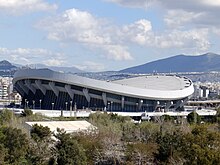Piraeus
[4] During the Golden Age of Athens, the Long Walls were constructed to fortify the route from the main settlement to the port (Piraeus).According to the ancient Greek historian Thucydides,[11] in 493 BC, Themistocles initiated fortification works in Piraeus, and later advised the Athenians to take advantage of its natural harbours' strategic potential instead of using the sandy bay of Phaleron.After the reinstatement of democracy, a general Conon rebuilt the walls in 393 BC, founded the temple of Aphrodite Euploia and the sanctuary of Zeus Sotiros and Athena, and built the famous Skeuotheke (arsenal) of Philon, the ruins of which have been discovered at Zea harbour.The destruction was completed in 395 AD by the Goths under Alaric I. Piraeus was led to a long period of decline which lasted for fifteen centuries.The Piraeus Lion itself was looted in 1687 by Francesco Morosini during his expedition against Athens (part of the Morean War) and was carried to the Venetian Arsenal, where it still stands today.Under Ottoman rule, especially before the beginning of the Greek War of Independence, Piraeus was mostly deserted, except for the monastery of Saint Spyridon (1590) and a customs house, and it was only used occasionally as a commercial port.There were at least two failed attempts to create a new town, the first in 1792 by bringing a population from Hydra and the second during the Greek War of Independence in 1825 by the installation of people from Psara, but it was not until 1829 that permanent habitation of the area was restarted.Piraeus at first developed into a small town with few dwellings, far from its glorious past as a prosperous city, with its population consisting largely of fishermen.Piraeus, from a deserted small town, quickly became the leading port and the second largest city in Greece, with its prime geographical location and closeness to the Greek capital helping it continually to grow, attracting people from across the country.After the decisive period for Greece of 1912–1922, Piraeus experienced a major demographic explosion, with its population almost doubling to reach 251,659 in 1928 from 133,482 in 1920, an increase owed to the arrival of Greek refugees from Asia Minor after the 1919–1922 Greco-Turkish War and the Greek genocide in Anatolia and finally the subsequent population exchange between Greece and Turkey.Although there was an increase in the labour force, a variety of social problems also emerged with the concentration of new populations in the suburbs of the city, such as Nikaia, Keratsini, Perama, Drapetsona and Korydallos.Piraeus is bounded by the Mount Aigaleo to the northwest, and the Saronic Gulf to the south and west, and connected with the rest of the Athens urban area to the east and northeast.In addition to the central one, called Kantharos in ancient times, the smaller harbours to the east are still in use: Zea, also known as Pasalimani, and Munichia, the smallest of the three and widely known as Mikrolimano and Tourkolimano .[36] Among the archaeological sites of Piraeus, parts of the ancient Themistoclean Walls and Eëtioneia, a mole in the entrance to the harbour, are still preserved in good condition.Excavations in Pasalimani revealed the Skeuotheke, an ancient structure where ship rigging equipment was stored, designed by architect Philon.While drilling in order to lay pipes, the Hydrex Company came across the hand of a bronze kouros (youth) at a depth of approximately 1.50 meters.Excavations began after the custodian of the local museum, Dimitrios Kalantonis, and the Director of the Archaeological Service, Yiannis Papdimitriou, were informed.However, the enthusiasm for the dig led to poor documentation of the details and context of the finds, leaving rare photos taken by the media or public as the only record.The Karaiskakis Stadium, built in 1885 as a bicycle track, enlarged in 1964 and completely rebuilt in 2004, is the second largest football venue in Greece with a capacity of 33,334 and one of the most modern in Europe.The Peace and Friendship Stadium, part of the Faliro Coastal Zone Olympic Complex and built in 1985 opposite to the Karaiskakis Stadium, is the second largest indoor arena in the country and one of the most impressive around Europe,[39] having hosted multiply major international events in several sports, including the volleyball tournament in the 2004 Athens Olympics, the 1998 FIBA World Championship, the EuroBasket 1987 and the Final Four of the Euroleague 1993.As a result, Greece's shipowners left Piraeus en masse in favour of operations in London, New York, Alexandria and other major shipping cities.[40][41] In 1967, when a group of colonels staged a coup d'état against the government, in order to increase desperately needed revenues, the junta offered lavish incentives for Greek shipowners to bring their companies back to Piraeus.This included both tax incentives and other inducements, as highlighted by the fact that Aristotle Onassis was allowed to purchase the entire island of Skorpios, which otherwise would have been a violation of Greek coastline laws.Mikrolimano and Bay of Zea, are the smaller harbours of Piraeus acts as Marinas, attract large numbers of visitors with their picturesque vistas and vigorous nightlife.















Piraeus (disambiguation)MunicipalityPiraeus stationPoseidonPiraeus Municipal TheatreGreeceAdministrative regionAtticaRegional unitPiraeusIoannis MoralisTime zonePostal codeArea code(s)Vehicle registrationPatron saintSaint SpyridonAncient GreekKatharevousaAthens urban areaSaronic GulfAthens Rivieraregional unit of PiraeusGreater Piraeusrecorded historyancient GreeceAthensGolden Age of AthensLong Wallsnaval basetriremeport of PiraeusEurope24th largest passenger port in the worldEastern Mediterranean2004 Summer OlympicsUniversity of PiraeusClassical AthensArchaeological Museum of Piraeus26th century BCMunichiaKastellaprehistoric timessalt fieldclassical timesPhaleron harbourHippiasCleisthenesThucydidesThemistoclesPeloponnesian WarLaurion minesAthenian fleetbattle of SalamisPersianssecond Persian invasion of GreeceThemistoclean WallsPericlesgrid planHippodamus of MiletusAthens plagueSpartansSalamisSpartanLysanderDelian LeaguetriremesRhodesThrasybulusbattle of MunichiaThirty Tyrantsbattle of PiraeusColossal statue of HadriandemocracyAphroditeAthenaPhilonAlexander the GreatLucius Cornelius SullaAlaric IByzantineConstantinopleVenetiansPiraeus LionOttoman GreeceOttoman EmpireFrancesco MorosiniMorean WarVenetian ArsenalGreek War of Independencemodern Greek stateAegean IslandsKing OttobourgeoisieCorinth CanalGreek refugeesAsia Minor1919–1922 Greco-Turkish WarGreek genocidepopulation exchange between Greece and TurkeyNikaiaKeratsiniPeramaDrapetsonaKorydallosWorld War IIurban areaagglomerationMount AigaleoKöppen climate classificationhot semi-arid climateHellenic National Meteorological ServiceNational Technical University of AthensNational Observatory of AthensWorld Meteorological OrganizationThemistocleanEëtioneianavy yardMount HymettustavernasVillage CinemasAgios Ioannis RentiHellenic Maritime MuseumFreatidaclassical antiquityPanos Aravantinos Decor Museum

